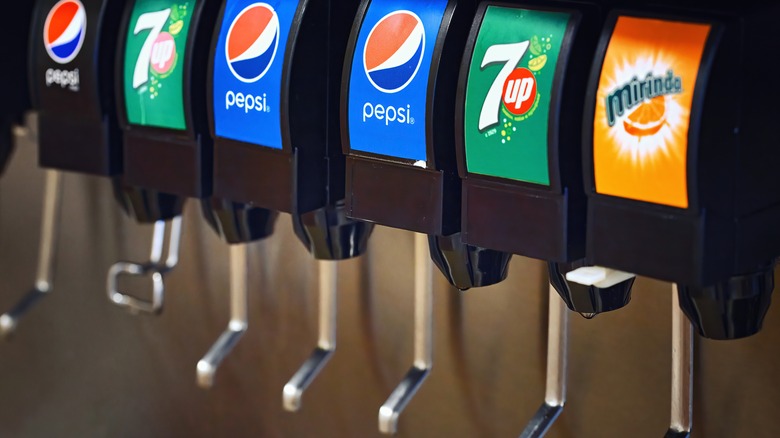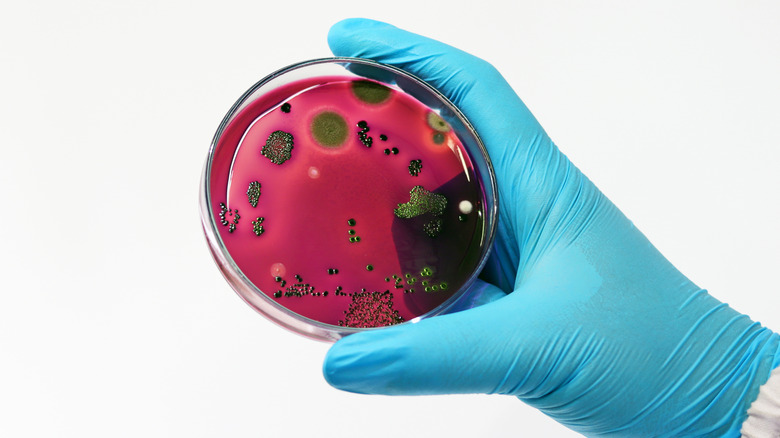Why You Should Think Twice Before Drinking Fast Food Soda
When you think of a classic soda fountain, the wholesome image of a 1950s diner complete with poodle skirts and bobby socks may spring to mind. After all, this was the era of "Happy Days," where teens danced the jive and sipped on root beer floats. Surely, this throwback to the "Golden Age" continues to spread joy to those who lap up its sugary contents, right?
There's no denying that soft drinks continue to play an important role in American society. According to Gallop, 48% of U.S. citizens consume a minimum of one soda a day. In 2018, it was reported that among people between 18 and 29 years of age, 49% drink soft drinks on a regular basis (via Statista). Furthermore, the United States holds the title of being the world's second-largest consumer of soft drinks, right behind Mexico. Amazingly, America's southern neighbors guzzle down "630 eight-ounce servings per capita per year." That's a serving of soda every day and, sometimes, two. When it comes to choosing between regular and diet soft drinks, one poll showed 32% of Americans opt for regular, while 24% select diet.
Clearly, Americans (and their neighbors) enjoy their sodas and the fountains that dole them out. But are fountain soft drinks equal to their bottled and canned cohorts? Prepare to be shocked — and more than just a tad revolted.
Some fountain drinks tested positive for E.coli
No matter what soda brand you prefer, it turns out that sugar is not the worse thing found in fountain drinks. A study published in the International Journal of Food Microbiology looked at 90 drinks from "20 self-service and 10 personnel dispensed soda fountains." Shockingly, almost half of these beverages contained coliform bacteria. What does that mean in layperson terms? According to the NY Department of Health, coliform bacteria resides in humans and animals, specifically in their digestive tracts, and exits the body via feces. The presence of coliform, therefore, could equate to the presence of fecal matter.
Either way, study author and professor at Hollins University, Dr. Renee Goddard, explained that a high number of beverages contained levels of bacteria and coliforms that would not be allowed in drinking water (via Eat This, Not That!). Yes, you are paying to drink something that your municipality would deem undrinkable. Even your ice cubes are risky as one UK report found fecal bacteria in ice at several fast food chains.
And that's not all. CNN explains that research also revealed the presence of both E.coli and "antibiotic-resistant microbes." The article goes on to explain that the Environment Protection Agency has determined that drinking water must not contain E.coli, yet these seemingly innocuous, carbonated beverages do.
As you recover from these shocking discoveries, you'll want to read on to learn what else may be lurking in your fizzy drink.
Some fountain drink machines contain mold and bleach
No one wants to chug down a mouthful of mold, but when you opt for a fountain drink, you may be doing exactly that. Did you just throw up in your mouth a little? Who could blame you? According to Fox 4, a series of state inspections in Southwest Florida revealed that roughly a dozen eateries in the region had beverage dispensers that contained "slimy mold-like substances." Mold builds up when beverage dispensers go too long without cleaning. Molds enjoy sugar as much as humans do and when these spores are allowed to remain undisturbed, mold thrives. Unfortunately, when employees try to clean the easiest and quickest way, they may just dump bleach in the pipes to remove the mold as one former fast food worker claimed in Thought Catalog. Now you're drinking mold residue and bleach.
While you may consider the carbonation and sugar content of your soda or opt for a diet soda option, nothing is quite as daunting as the fountain drink. After all, depending on where you're buying your fountain equivalent, you may be playing a game of beverage Russian Roulette. What will it be today folks? Mold, fecal contamination, E. coli, or a mouthful of bleach? Perhaps, you'll hit the jackpot and get a slurry of all four.


